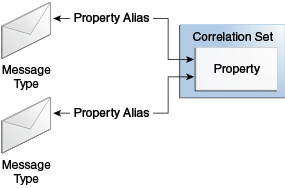Understanding Correlation Set Contents and Concepts
This section provides an overview of key correlation set concepts.
The correct BPEL instance using correlation sets is obtained as follows:
-
A BPEL process provides a construct called a correlation set to allow for custom correlation.
-
A correlation set is a collection of properties used by the BPEL process service engine to identify the correct process to receive a message.
-
Each property in the correlation set can be mapped to an element in one or more message types through property aliases. Figure 9-1 provides an overview.
Note the following key correlation guidelines:
-
Only the process receiving the message is concerned about correlation. As long as the sending service includes sufficient information in the message to correlate it with previous activities, the sender does not need to be aware that correlation is occurring.
-
Correlation properties must be unique for the duration of the life of the BPEL process that sets them.
-
Ensure that no two processes are working with the same correlation tokens. For example, using social security numbers to correlate an expense claims process is not recommended if you start two separate instances of the process.
-
Properties can be made up values or actual business identifiers such as purchase orders or numbers. They do not need to be strings; they can be any reasonable XML type.
Key correlation concept attributes are as follows. You set these attributes in Oracle JDeveloper when designing a correlation set with the Correlation wizard:
-
An initiate attribute is set as follows:
-
yes: The correlation set is initiated with the values of the properties available in the message being transferred.
-
no: The correlation set validates the value of the property available in the message.
-
-
A pattern attribute is set as follows:
-
in (for BPEL 1.1) or response (for BPEL 2.0): The correlation property is set and validated on the incoming message.
-
out (for BPEL 1.1) or request (for BPEL 2.0): The correlation property is set and validated on the outgoing BPEL message.
-
out-in (for BPEL 1.1) or request-response (for BPEL 2.0): The correlation property is set and validated on both incoming and outgoing messages.
-
-
Property aliases map a global property to a field in a specific message part. This action enables the property name to become an alias for the message part and location. The alias can be used in XPath expressions.
